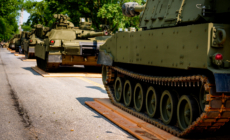-
If Trump Wants War With Iran, Let’s Hear From Congress First - 14 mins ago
-
Satellite Images Show US Navy Vessels Deploy as Possible Iran Attack Looms - 38 mins ago
-
Aiming at the Dollar, China Makes a Pitch for Its Currency - 58 mins ago
-
Map Shows U.S. Middle East Travel Warnings as Possible Iran War Looms - about 1 hour ago
-
Trump’s Conflicting Messages on Workplace Raids Leave Businesses Reeling - 2 hours ago
-
China Reacts to Trump Khamenei Threat - 2 hours ago
-
Ted Cruz Hits Out at Tucker Carlson After Interview Moment Goes Viral - 2 hours ago
-
The Dark Side of China’s Gold Frenzy - 2 hours ago
-
Woman Killed by Trump Military Parade Convoy Carrying Tank - 3 hours ago
-
Trump Skips Zelensky Meeting as G7 Talks End With Little for Ukraine - 3 hours ago
Guantánamo Bay Prepares for President Trump’s Migrant Surge
About 200 Marines and soldiers landed at Guantánamo Bay over the weekend to provide security and begin setting up at a new tent city for migrants, as officials comply with President Trump’s order to prepare the Navy base for as many as 30,000 deportees.
The small base in southeast Cuba is on the verge of undergoing its most drastic change since the Pentagon opened its wartime prison there after the Sept. 11, 2001, attacks.
The operation will require a surge of staff and goods to the isolated base, which is behind a Cuban minefield and is entirely dependent on air and sea supply missions from the United States.
Everything from pallets of bottled water and frozen food for the commissary to school supplies and government vehicles come twice a month on a barge. Fresh fruits and vegetables for the 4,200 residents come on a weekly refrigerator flight.
Fulfilling the president’s order could grow the population there tenfold because of the staff it would take to operate the encampment, which is on a unpopulated corner of the base, far from the prison as well as the commissary, school and suburban-style neighborhoods for service members and their families.
In response to Mr. Trump’s order, U.S. forces have already put up 50 Army green tents inside a chain-link-fence enclosure, adjacent to a barracks-style building called the Migrant Operations Center.
The first wave of about 50 Marines arrived Saturday night from Camp Lejeune, N.C. The next 50 arrived on Sunday.
The military declined to comment on its current capacity to receive the migrants or on what other provisions were inbound. The Southern Command, which has oversight of the troops assigned to the prison and the migration plan, would not say who is in charge of the operation or discuss a plan from 2017, obtained by The New York Times, for detaining the first 11,000 migrants there.
The 15 prisoners have been held in two prison buildings with about 275 cells. Detaining migrants at that site would presumably require moving those 15 prisoners into one of the two buildings.
But no decision has been made on whether some migrants would be housed at the wartime prison, a Defense Department official said Saturday. Separately, two people with knowledge of detention operations said the consolidation had already happened this weekend. All of them spoke on the condition of anonymity to discuss sensitive security arrangements involving the prison, which are sometimes classified.
In his remarks last week, Mr. Hegseth also mentioned that about 6,000 deportees could be housed “on the golf course,” which is near the base’s McDonald’s, Irish pub and family housing.
In any case, carrying out Mr. Trump’s order would require a huge undertaking, said retired Maj. Gen. Michael R. Lehnert, a Marine who opened the prison in 2002.
General Lehnert, whose expertise as a Marine was in engineering, also managed security for the migrant arrivals at Guantánamo in the 1990s, when tens of thousands of Cubans and Haitians lived in tent cities around the base.
At its peak, he said, in May 1995, the camps held 25,000 migrants, mostly Cubans.
The base was so overwhelmed that a tent camp was even, briefly, put on the golf course. The operation was set up hastily, and it had portable latrines. As the numbers rose, the Navy closed the school and evacuated the families of service members to the mainland for seven months.
The base makes its own water for everything except drinking purposes and, as it did then, would need to make much more.
The two main sites that were used back then — a vast bluff overlooking the ocean and an abandoned airfield — now have new purposes. One is a closed military zone, with the prison buildings and staff. The other has the courthouse facility called Camp Justice.
President Trump’s order called for expanding the Migrant Operations Center to accommodate 30,000 people. It is currently a 120-bed former barracks that in recent years housed Cubans, sometimes families, whom the U.S. Coast Guard found at sea trying to reach Florida. They were housed there until a third country agreed to receive them.
The 2017 plan, reflected in a diagram of preparations for area surrounding the Migrant Operations Center, shows six designated tent camps for more than 11,000 migrants, and a nearby spot to house 3,640 “blue forces,” a military term for forces that are friendly to the U.S. military. The largest camp could house more than 3,000 migrants.
By 2017 contractors had already built crude summer-camp-style showers and toilet houses in cinder-block buildings on the site.
In the 1990s, General Lehnert said, each tent encampment contained 1,500 migrants and was guarded by 200 troops, either soldiers or Marines. And that was just for basic security. The 1990s operation, known as Sea Signal, also had medical, logistics and other support troops as well as a separate “rapid reaction force” in the event of unrest.
It was not known whether the Department of Homeland Security or the U.S. military would handle processing, or what role, if any, would be assigned to the International Organization for Migration, which has an office on the base. Nor was it clear how it would be funded.
Guantánamo is an expensive place to live and work. In 2019, the commander of detention operations estimated it cost more than $100,000 for each guard’s nine-month deployment to the facility. Those troops are provided with housing, clothing, food, health care, entertainment and transportation.
Those living at Guantánamo today, in addition to sailors and their families, include schoolteachers, Filipino and Jamaican guest workers, and the prison guard force of mostly individual soldiers serving on nine-month tours.
Mr. Hegseth did one of those tours, from June 2004 to April 2005. He was the platoon leader of 40 or so men from the New Jersey National Guard who provided perimeter security for the detention center.
But it is a much smaller operation today. Mr. Hegseth was part of a nearly 2,600-member military force that was assigned to the detention operation, which held 600 detainees on the former site of migrant camps. The airstrip was a busy place then, with resupply missions, troops, reporters, and members of Congress and the intelligence community flying in frequently.
Now the prison has a staff of 800 military and civilian contractors and no longer has a media operation.
An additional 111 military police from the New York National Guard were undergoing three weeks of training at Fort Bliss, Texas, before heading to a nine-month security mission at Guantánamo Bay.
The situation was changing so quickly that when the unit departed last month, the Army said it would provide security for the detention facility. But the Pentagon said in a statement released on Thursday that the unit would secure the Migrant Operations Center.



















